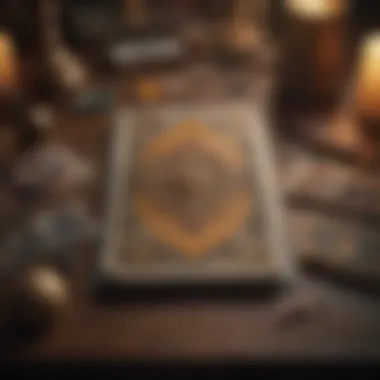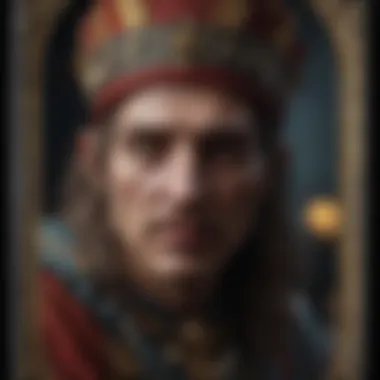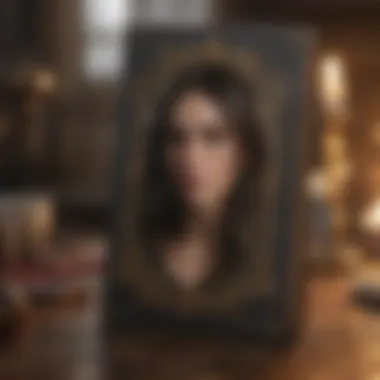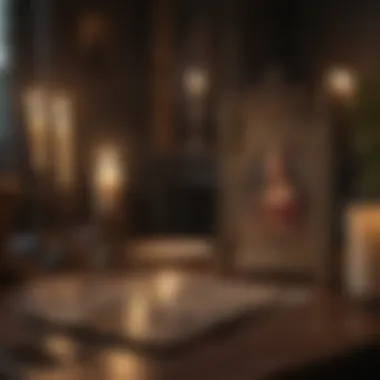Exploring Tarot Cards for Personal Insight and Growth


Intro
Tarot cards hold a complex place in the realm of personal insight. Their history intertwined with mystical practices and psychological exploration, these cards offer pathways to self-discovery and deeper understanding of one’s emotions and thoughts. As we delve into this guide, we will discuss how tarot can function as a lens for introspection, a means of guidance, and a tool for personal growth.
Each section will examine the role of tarot in our lives, encompassing the interpretive methods, different types of readings, and the meanings behind the cards. Through this exploration, both novices and those familiar with tarot will come to appreciate its power within a broader context of spirituality and intuition.
In considering the significance of tarot, it becomes clear that these cards are not merely tools for fortune-telling. Instead, they serve as mirrors reflecting our innermost thoughts, desires, and fears, helping us navigate the complexities of decision-making and personal evolution.
Understanding tarot's role involves not only grasping its historical roots but also recognizing its psychological and metaphysical dimensions. By appreciating these factors, we can uncover how tarot facilitates self-reflection and fosters a greater sense of self-awareness.
With this foundational understanding set, we will now explore Zodiac profiles, their intersection with tarot, and how these astrological elements enhance personal insight through individual card interpretations and readings.
Preface to Tarot Cards
The world of tarot cards extends far beyond simple divination; it intertwines with elements of self-discovery and personal insight. Understanding tarot starts with recognizing its history and contextual significance. This article explores how tarot serves as a transformative tool for individuals seeking clarity in their lives. Readers will uncover how it approaches introspection, promotes intuitive thinking, and offers guidance through complex situations.
Historical Origins
Tarot cards have an intriguing history, with origins tracing back to the late 14th century in Europe. Initially, tarot decks were used for playing card games rather than fortune-telling. The transition from gaming to a tool for spiritual exploration began in the 18th century.
Key developments in tarot history include:
- The Visconti-Sforza deck, one of the oldest known tarot decks, revealing the early aesthetic and symbolic essence of tarot.
- The Rider-Waite-Smith deck, which further popularized tarot for divinatory purposes with its rich imagery and accessible designs.
- The emergence of various schools of thought that shaped the interpretation and philosophy behind tarot.
The journey of tarot shows its evolving nature from mere entertainment to a serious spiritual practice.
Cultural Significance
Tarot cards hold significant cultural value across various societies. They are not limited to one belief system but instead intermingle with multiple traditions, nurturing diverse interpretations.
Some important points include:
- In modern contexts, tarot is often used in discussions about spirituality and wellness, appealing to those interested in personal growth and introspection.
- Various cultures have adopted tarot practices, each interpreting the cards in line with their unique beliefs and values.
- Tarot has inspired a range of artistic works and literature, influencing how people view mysticism and self-awareness.
"Tarot acts as a mirror, reflecting not just external circumstances but also the internal struggles of the user."
In summary, understanding tarot cards provides insights into their historical and cultural contexts, establishing a solid foundation for personal exploration.
Structure of Tarot Decks
Understanding the structure of tarot decks is essential for those exploring how tarot can aid personal insight. Each deck consists of distinct elements that serve various purposes in a reading. Familiarity with the arrangement and function of these components enhances one's ability to interpret messages from the cards.
Major Arcana Explained
The Major Arcana consists of 22 cards and represents significant life themes and spiritual lessons. These cards are generally seen as the core of any tarot reading. Each card in this section has a unique meaning and embodies distinct archetypes. For instance, The Fool symbolizes new beginnings and potential, while The World signifies completion and fulfillment. When these cards appear in a reading, they often highlight critical events or pivotal moments in the querent's life.
One benefit of understanding the Major Arcana is its guidance in recognizing life's cycles. When consulting with these cards, the reader can gain insight into challenges and opportunities that might arise. This connection to archetypes can help individuals reflect on their own experiences, drawing parallels to the themes presented in these cards.
Minor Arcana Components
The Minor Arcana features 56 cards divided into four suits: Cups, Pentacles, Swords, and Wands. Each suit deals with different aspects of human experience. Cups relate to emotions and relationships, Pentacles represent material matters and stability, Swords address challenges and thoughts, while Wands inspire creativity and action.
There are benefits to exploring the Minor Arcana as well. The nuances within these cards offer insights into day-to-day experiences. For instance, while a Major Arcana card might indicate an overarching theme, a Minor Arcana card might reveal the details influencing that theme. Such layered interpretations enable a comprehensive understanding of life's complexities.
Suits and Categories
Each suit within the Minor Arcana further breaks down into numbered cards and court cards, which include Page, Knight, Queen, and King. The numbered cards often represent stages of development related to the suit’s domain, while court cards may indicate people present in the querent's life or aspects of their personality.
Understanding the suits and categories adds depth to readings. Recognizing which suit a card belongs to helps the reader grasp the context of the issue being addressed. This organization encourages the querent to examine their lives from multiple perspectives, revealing connections between their thoughts, feelings, and actions.
The intricate structure of tarot decks not only aids in interpretation but also serves to deepen the querent's self-awareness.
Tarot decks are more than mere cards; they are mirrors reflecting our inner selves and guiding us through our experiences.


In summary, grasping the structure of tarot decks enhances the reading experience, allowing individuals to engage more profoundly with the insights offered through the cards.
The Purpose of Tarot Cards
The purpose of tarot cards extends beyond mere fortune-telling. They serve as a unique tool for personal insight and self-discovery. Through the intricate designs and symbolism of each card, individuals can reflect upon their lives, confront deep-seated beliefs, and facilitate personal growth. This section discusses how tarot offers pathways to introspection and enhancement of one's intuitive abilities.
Introspection and Self-Reflection
Introspection plays a vital role in understanding ourselves better. Tarot cards provide a framework for this examination. When a person engages in a reading, each card drawn can represent aspects of their psyche, experiences, and challenges. This process encourages deep self-reflection, prompting individuals to consider their motivations and feelings. A tarot reading can be an invitation to explore aspects of life often left unaddressed.
Using tarot for introspection can yield various benefits:
- Clarification of Thoughts: As individuals reflect on card meanings, they can gain clarity about their current situations.
- Identifying Patterns: Tarot readings help reveal recurring themes in one’s life, illuminating areas that may need transformation.
- Fostering Mindfulness: Engaging with the cards allows a moment of pause, encouraging presence in the moment.
It is essential to approach this practice with an open mind, ready to receive new insights. Tarot helps bridge the gap between the subconscious and conscious mind, enabling a more profound understanding of one's inner self.
Enhancing Intuitive Abilities
Tarot can significantly enhance intuitive abilities. The cards serve as catalysts for tapping into one's innate instincts. Each reading encourages individuals to listen to their inner voice and trust their intuition. The symbolic nature of the cards enables personal interpretations, fostering a deeper connection to intuitive wisdom.
Enhancing intuition through tarot involves several key factors:
- Active Engagement: Interacting with tarot cards encourages practice in recognizing intuitive signals. The more one uses tarot, the more attuned they become to their instincts.
- Exploration of Symbolism: Understanding the symbolism in tarots can enhance one’s ability to make connections beyond surface meanings. Each interpretation becomes a form of intuitive insight.
- Developing Interpretative Skills: Learning to interpret cards enhances decision-making abilities. Readers learn to navigate choices more confidently, guided by their intuition.
Types of Tarot Readings
Understanding the different types of tarot readings is crucial for anyone interested in using tarot cards for personal insight. Each reading type serves distinct purposes and can offer unique advantages depending on the querent's needs.
Single Card Draws
Single card draws are perhaps the simplest form of tarot reading. They require only one card and can be very effective for quick insights or daily guidance. The simplicity of this method makes it accessible to both beginners and seasoned readers.
By asking a specific question, the reader draws a single card to provide insight into a certain issue or decision. This approach encourages focusing on one aspect of a situation and allows for a more concentrated interpretation. It is useful for moments when clarity is needed but time is limited.
Benefits of Single Card Draws
- Focus: It narrows down the scope of inquiry, making card meaning more straightforward.
- Quick Insights: Ideal for situations requiring immediate responses.
- Encourages Intuition: Often allows the reader to reflect on personal feelings toward the card.
Three-Card Spreads
The three-card spread expands on the single draw by providing a broader view of circumstances. It commonly represents past, present, and future, but other interpretations are also frequent. This layout helps to establish connections between different timeframes or aspects of a question.
Interpretation of Three-Card Spreads
- Past: This card signifies influences from history that are affecting the current situation.
- Present: It represents the current situation and the immediate influence surrounding it.
- Future: The final card outlines potential outcomes or directions based on the current path.
Benefits of Three-Card Spreads
- Contextual Understanding: Offers a narrative arc to the query, helping the reader see patterns.
- Versatility: Can be adapted for different questions beyond just timing.
- Deeper Insight: Encourages narrative thinking where the querent can relate personal stories to the reading.
Celtic Cross Layout
The Celtic Cross is often seen as one of the most complex tarot layouts. It consists of ten cards and provides a comprehensive overview of a situation. While it can require more time, it is valuable when tracking intricate life themes or decisions.
The layout is typically divided into two main sections: the cross and the staff. The cross provides insight into the main influences surrounding the situation, while the staff delves into broader influences and long-term considerations.
Benefits of the Celtic Cross
- In-depth Analysis: Allows for a multifaceted exploration of circumstances.
- Clarification: Offers clarity on various aspects of a situation, looking at internal and external factors.
- Holistic Perspective: Useful for integrating different facets of personal life, such as emotional, spiritual, and physical aspects.
Understanding the different types of tarot readings enables the querent to make informed choices regarding how to approach their inquiries. Each method provides distinct benefits, catering to varying levels of complexity and depth of exploration.
Interpreting Tarot Cards


Interpreting tarot cards is a fundamental component in understanding their significance and potential impact on personal insight. This section delves into the intricacies of card interpretations, helping readers to recognize the multilayered meanings behind each card. Interpreting tarot goes beyond mere definitions; it involves grasping the nuances of feelings, situations, and events that cards can represent. This understanding can facilitate self-reflection, enhance decision-making, and provide clarity in uncertain times.
Understanding Card Meanings
Each tarot card holds a unique meaning, which can change depending on its position within a spread and the overall context of the reading. The Major Arcana cards often signify significant life events or spiritual lessons. In contrast, the Minor Arcana cards reflect day-to-day challenges and experiences. For example, the Fool card can symbolize new beginnings and spontaneity, while the Tower card might represent sudden change or disruption.
When interpreting card meanings, it is essential to consider both the traditional interpretations and personal associations. Each reader may have different experiences and feelings associated with specific cards. This personal connection can enrich the reading process, allowing for a more profound understanding of the messages conveyed. Being familiar with the upright and reversed meanings of cards further supports clarity of interpretation.
Contextual Interpretation
Contextual interpretation involves considering the surrounding cards and the question posed during the reading. Each card does not exist in isolation; its meaning may shift dramatically based on its neighbors in a spread. For instance, if the Death card appears in a spread next to the Sun card, the interpretation could lean towards positive transformation rather than dread of endings.
Key points to consider in contextual interpretation include:
- Question Focus: The essence of the inquiry shapes how each card is viewed. A question regarding love will elicit different insights than a question about career.
- Card Position: The position of a card in a spread often alters its meaning, suggesting influences from the past, present, or future.
- Reader's Intuition: Personal intuition plays a significant role in arriving at nuanced interpretations. The ability to listen to one's instincts can enhance the overall reading experience.
Understanding context is vital. It combines card meanings and individual insights, leading to a richer interpretation.
The Psychological Aspect of Tarot
The exploration of Tarot cards goes beyond their historical and structural aspects. It opens a doorway into the psychological realm of personal insight and self-awareness. The psychological aspect of Tarot is essential for understanding how these cards can facilitate introspection and personal growth. Using Tarot as a reflective tool, individuals can navigate their emotions, thoughts, and behaviors, promoting a deeper understanding of themselves.
Tarot as a Therapeutic Tool
Tarot can act as a therapeutic instrument by providing a structured method for introspection. It helps users to articulate their thoughts and feelings, guiding them toward clarity. Each card can prompt reflection on different aspects of life. For example, a single card may invite contemplation on relationships, career choices, or personal goals.
When engaging with Tarot, individuals often find that the imagery and symbolism resonate with their situation. This resonance can lead to catharsis, enabling them to process complex emotions. Research has shown that creative expression, including visual methods, enhances therapeutic outcomes. In this sense, Tarot can serve to bridge the gap between conscious thoughts and subconscious insights.
- Benefits of using Tarot therapeutically include:
- Improved self-awareness and understanding of behaviors.
- Enhancing emotional expression and processing.
- Gaining insights into life challenges and pathways.
- Supporting cognitive restructuring, allowing for new perspectives.
Cognitive Dissonance and Tarot
Cognitive dissonance is the mental discomfort experienced when holding conflicting beliefs. Tarot can assist in navigating this dissonance through exploration and reflection. When individuals draw cards that contradict their current thoughts or beliefs, it prompts them to reevaluate their positions. Tarot encourages the confrontation of these contradictions, leading to potential growth.
Through the lens of Tarot, one can examine their internal conflicts in a non-judgmental manner. The process of interpreting the cards allows for a safe space to engage with discomforting truths. As an example, if a person feels stuck in a job that contradicts their values, the cards may reveal deeper desires or fears. This exploration can lead to clarity and ultimately, more aligned decisions.
Common Misconceptions
Misunderstandings surrounding tarot cards often cloud their true purpose and value. Clarity on these misconceptions is necessary for deeper engagement with tarot as a tool for personal insight. This understanding allows individuals to navigate their inner landscapes more effectively.
Tarot and Fortune-Telling
Many people link tarot cards exclusively with fortune-telling. This association stems from popular culture where tarot is frequently portrayed as a method to foresee the future. In reality, while some users may attempt to predict specific outcomes, the essence of tarot lies in self-exploration rather than clairvoyance.
Tarot provides a framework for reflection. Each card drawn prompts introspection about one’s current situation, feelings, and potential pathways. Its role is less about telling what will happen next and more about illuminating options available in the present. Tarot serves as a mirror, revealing underlying thoughts and emotions, facilitating personal growth rather than dictating fate.
Skepticism Towards Tarot
Skepticism is a common response to tarot cards, especially in rational communities. Critics argue that tarot lacks scientific validation and thus does not hold merit. However, it is essential to consider that tarot functions on psychological and emotional levels. The cards encourage individuals to confront their thoughts and feelings, fostering self-awareness.
Although skeptics may dismiss the practice, the value of tarot can be seen in its accessibility and adaptability. People find that engaging with the cards can lead to valuable insights, regardless of belief in supernatural elements. Respecting different perspectives strengthens the discourse surrounding tarot, inviting both skeptics and enthusiasts to explore its multifaceted nature.
“The true value of tarot may not be in prediction, but in the profound self-discovery it enables.”
By addressing misconceptions regarding tarot, individuals can approach it with a more open mind. Understanding its primary intent as a tool for self-discovery and personal insight enhances its relevance in today’s holistic practices.
Integrating Tarot into Daily Life
Integrating tarot into daily life can offer a wealth of benefits and enhance one's personal growth journey. The practice transcends mere fortune-telling, serving instead as a tool for introspection and emotional clarity. This approach allows individuals to cultivate a deeper understanding of their thoughts and feelings, engage with their inner selves, and guide their decisions through insightful reflections. Additionally, incorporating tarot into everyday routines can help forge a stronger connection with intuition, enabling a more harmonious balance between mind and spirit.
Routine Card Pulls


Routine card pulls are a straightforward yet poignant way to infuse tarot into daily life. This practice usually involves drawing one card from the deck each day. The selected card serves as a focal point, inviting contemplation throughout the day. It becomes a touchstone for reflection and engagement.
Some benefits of routine card pulls include:
- Daily Insight: A single card can illuminate current feelings or situations, prompting self-awareness.
- Mindfulness Practice: Engaging with the card encourages a pause in daily activities for reflection.
- Theme Identification: Frequent pulls reveal patterns or themes over time, deepening self-understanding.
This method is suitable for anyone, regardless of tarot experience. The simplicity of this practice encourages consistency, allowing insights to accumulate.
Using Tarot for Decision-Making
Tarot can play a significant role in decision-making processes. When faced with choices, tarot readings can offer alternative perspectives and clarify thoughts. For example, a three-card spread might detail options, potential outcomes, and guidance.
Here are some aspects to consider:
- Clarity: Tarot can help distill complex feelings into clearer insights.
- Empowerment: It encourages a proactive approach, allowing individuals to weigh their options thoughtfully.
- Reflection: The cards prompt deeper examination of one’s motivations and desires behind a decision.
Using tarot in this way can shift a person’s approach toward choices, helping them make decisions that align more closely with their true selves.
Journaling with Tarot
Journaling with tarot involves keeping a record of readings, reflections, and insights gained from cards. This practice enhances understanding and allows for progression tracking over time.
Benefits include:
- Retention: Writing down insights helps solidify the understanding and makes it easier to recall lessons learned.
- Emotional Expression: It serves as an outlet for emotions and thoughts, which can lead to greater clarity.
- Progress Tracking: Regular entries can spotlight personal growth and shifts over time.
Each journaling session can start with a card pull, setting a theme for the entry. This creates a structured yet fluid method to engage with both tarot and one’s own experiences.
Incorporating tarot into daily life transforms it from a simple card-reading exercise into a powerful tool for self-exploration and decision-making.
Integrating these practices allows tarot enthusiasts to enhance their intuitive abilities and deepen their understanding of themselves. As individuals establish these routines, they may discover new inquiries about their life's journey. This iterative process promotes growth, leading to meaningful insights and wiser choices.
Ethical Considerations
The realm of tarot is rich and extensive, and with its depth comes a significant responsibility that both readers and querents must acknowledge. Ethical considerations in tarot are paramount as they serve to protect the integrity of the practice and the wellbeing of individuals involved. Understanding these considerations ensures a respectful and meaningful engagement with tarot.
Respecting Personal Boundaries
Every individual approaches tarot with different levels of openness and vulnerability. Recognizing personal boundaries is crucial. It's important for tarot readers to cultivate a space that allows clients to disclose their thoughts, fears, and desires at their own pace.
This respect for boundaries includes:
- Discussing topics before a reading. Readers should clarify how much personal information the querent wishes to share.
- Maintaining confidentiality. Anything discussed during a reading must remain private. This builds trust and comfort.
- Validating feelings without imposing personal beliefs. Readers should allow clients to feel heard, avoiding judgments.
By establishing these practices, readers create a safe environment, which can then enhance the quality of insights gained from the reading.
Clarifying Reader Responsibilities
Tarot readings can have profound implications on an individual’s mindset and decisions. Therefore, it is essential for readers to clearly outline their role and responsibilities before a session. They should communicate that the insights offered through tarot are not absolute predictions nor directives.
Key responsibilities include:
- Providing guidance, not a guarantee. Remind clients that tarot serves as a tool for self-reflection rather than an oracle that dictates the future.
- Encouraging personal agency. Clients should feel empowered to make choices based on their own intuition and life circumstances, rather than simply following the cards.
- Acknowledging limitations. Readers should be transparent about the scope of their interpretations, making it clear that they are not licensed mental health professionals.
“The role of the reader is to illuminate paths rather than to direct them.”
In summary, ethical considerations in tarot are vital both for the reader's integrity and the querent's experience. By respecting personal boundaries and clarifying responsibilities, tarot can provide profound insights without compromising individual wellbeing.
Finale
In examining the multifaceted role of tarot cards, it becomes evident that these tools are not mere relics of superstition but vehicles for personal insight and growth. This article has outlined how tarot serves as a mirror, reflecting back the hidden facets of our psyche and helping us navigate the complexities of life.
Recapitulating Tarot's Role
Tarot cards facilitate introspection and self-discovery. They offer a unique way to engage with one's thoughts, feelings, and circumstances. By drawing on decades of tradition, tarot provides a method for individuals to connect with their subconscious. When one engages with the imagery and symbolism of tarot, it encourages exploration beyond day-to-day thinking. This exploration can lead to insights about personal values, strengths, and challenges. Furthermore, tarot can guide individuals in making decisions and help to assess the emotional or mental blocks that may hinder progress.
Future of Tarot Practices
The future of tarot practices appears to be evolving with the changing landscape of personal development. As more people seek methods for self-improvement and emotional resilience, tarot is likely to gain broader acceptance as a legitimate tool for personal insight. Technology plays a growing role, as apps and online platforms provide resources for learning and practice. Also, integrating tarot with other personal development practices, such as mindfulness or coaching, could enhance its relevance in contemporary society. By maintaining an open mind and adapting to the needs of individuals, the practice of tarot can solidify its place in the fabric of holistic approaches to personal growth.
Tarot invites us to engage in a dialogue with ourselves, using the cards as a language of intuition and understanding.



